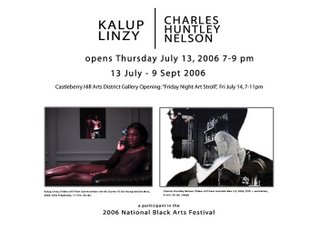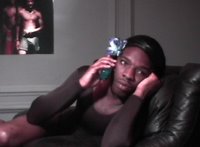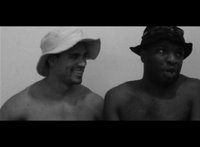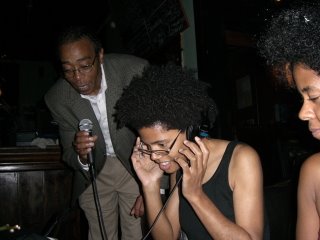
This was an inspiring night at the Eyedrum Gallery in Atlanta, Georgia. There were folks from the National Black Arts Festival (NBAF) and National Alliance of African American and African Art Support Groups 8th Annual Conference, plus local artists and art lovers were in attendance. A mixed crowd of parents and kids, older folks young folks, black, Asian, white, punks, post-punks, funksters, dreds, old school and new school, and a little black girl who listens to Anthony Braxton, and can hang with the old folks 'til 1am: they were all there to bear witness to the premier of the Carbonist School's Study Hall.
I've already blogged in short about the Carbonist School
here and
here, and I wanted to get some extended musings down plus more pics. Participating artist and Carbonist School co-founder Cauleen Smith generously sent me some pics to include, so you can read or just look at the pretty
(Beatrice L. Thomas, I Stand Alone) pictures or both (all photos are by Cauleen Smith except where noted). I had hoped to put up some short-short audio, ambient and otherwise, but the studio where I normally work is undergoing some major repairs.
Lets take the tour. When you first walk in you see the Carbonist School founders and a short statement and then entering the show Beatrice L. Thomas'
I Stand Alone, a suspended fiber and wire multimedia piece. When I first saw it, the work transmitted a "Miss Otis Regrets" sensation--an elegant line and posture, a fierceness fed by profound vulnerability and fragility--when I first heard "Miss Otis Regrets" and many times thereafter it was sung with understated drama by Jose Feliciano with spare guitar accompaniment. But then I saw it again today and it looked so different, more roughhewn, as the natural light cam through the gallery's galss doors and lit the piece from behind. Was it me, or was the piece like seeing actor Khandi Alexander play sophisticated vixen, then put upon yet wise older sister, then vulnerable crackhead (shoulda gotten a Golden Globe nod for that), then glamorous forensic specialist? I'm not even being facetious, because this is the kind of art I like. It keeps mutating, it keeps creating itself even after the physical hand of the artist has

ceased manipulating its materials. Next the focus shifts to Cauleen Smith's
The Green Dress video installation, and Torkwase Dyson's multimedia installation,
The Spook Who Sat By the Door, Drove the Truck, Wrote the Rhyme, Broke the Code, and Walked on Water.
 (above left and right, views of Cauleen Smith's The Green Dress)
(above left and right, views of Cauleen Smith's The Green Dress)I wish I had the time to just sit in front of Smith's piece, volume up, and watch all four monitors simultaneously and then watch each one individually. It's beautiful work, and again the mise-en-scene is just so accomplished, so many visual elements are signifying in each scene but there's always a sense of balance in the frame. Smith told me that this work was an attempt to create something of a new cinematic language using traditional cinematic formalist elements. I look forward to seeing where she goes next. Dyson means her work to have narrative referents

and this piece can literally be read in symbolic form from left to right with the trucks, the code and water appearing in titled order across the surface of the work. In quiet moments you can also hear code sound effects, emanating from the piece.
 (left, detail of code projection)
(left, detail of code projection) (left, detail of LCD belts)
(left, detail of LCD belts)In the middle of the space you can look left and see Greg Tate's video,
The Day After Superfly: A Brief History of the Unconscious in Harlem 1972-2012,
(below right, a still from Tate's video) appearing on a large

monitor and on the right would be Charles Huntley Nelson's
Invisible Man 2.0 watercolor series. Nelson's series explores the interstices between H.G. Wells' speculative novel,
The Invisible Man (1897)and Ralph Ellison's arguably experimental and speculative opus
Invisible Man (1953) and their respective influences on Nelson himself, apparent in his utlization of his visage as a frame. The watercolors are representations of stills from Nelson's
Invisible Man 2.0 digital video which incorporates footage from the 1933 film adaptation,
The Invisible Man, starring Claude Rains. The video can be seen at
Romo Gallery along with additional watercolors. What intrigues me about these pieces is the way that Nelson employs angles along with light and shadow to create textured layering and a simultaneous optical effect of the figures within the frame of his self-portrait both receding into and emerging out of Nelson's head.
(below left, wide view of The Sour Thunder audio installation, and Invisible Man 2.0 watercolors)
Look dead ahead and you'll see the audio set up for Mendi + Keith Obadike's Sour Thunder internet opera.
(below right, placard from The Sour Thunder audio installation)

Go through the open doorway to the next main room and you would have seen beverages on your right. To your left are Carbonist School Manifesto declarations illustrated and writ large courtesy of co-founder and exhibition organizer Cinqué Hicks. A visual artist in his own right, Hicks was too immersed in the mounting of the exhibition to include his own work, but did find the time to create these graphic works for the Opening.


On your right two monitors screen a documentary on the school's founding with co-founders Hicks, Cauleen Smith, Beatrice L. Thomas, and Lanneau White talking and conducting science experiments, courtesy of Smith. The dual monitor set up provides alchemy, conversation, and voice over between the founders, the documentary eye, and the audience.
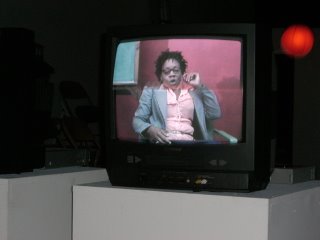 (left, Cauleen Smith signifying in an image from the Carbonist documentary)
(left, Cauleen Smith signifying in an image from the Carbonist documentary)Make a U-Turn and walk right, now and you're in front of the wall video projection of Chieke Chieke's
three creation theory, digital video. Starting with the anxious caress of black, bones and color enveloped materials rise up to further reveal naked skin, the first. Layers of black, white and finally red--carbon, milk, and blood according to Chieke--are revealed as the silently intoning Chieke sits, eyes closed, her head gesticulating as though in midst of spirit possession or in this case the birth of consciousness.

Behind you is Jabari Hall-Smith's
Lil' Big Head (aka The Return of Afrifa Makuffo Jackson). A sci-fi engagement of power, vengeance and freedom, Hall-Smith's video is playful, surreal, epic, and at times meditative. There is a singular look about the work, his enthused and rich sense of color and art design is obvious, I really liked his casting and his bold way with layered animation.



If you come from around the partial wall enclosing that video monitor you'll see Kevin Sipp's
Sun Ra P-Funks the Zulu Nation, or notes on black star initiation devices (formerly
Untitled).

 (right, Sipp full view and detail; photos audiologo; below, close up detail; photo Cauleen Simpson)
(right, Sipp full view and detail; photos audiologo; below, close up detail; photo Cauleen Simpson)
Some flashes of Sipp's vinyl technological etymologies:
•
Outer rotation: 12 Tribes Flow Sun Ra Star-Fari Mu Cipher
•
Middle rotation: Secret 77 Love $ ...
• Inner Rotation: 33 1/3 2 OM 45 ...
•
Center Label: Red X File
My conversation with Kevin Sipp was being on the receiving end of the Cipher Files. He broke down the Sun Ra-P-Funk-Vodun-Bambaataa geneologies, and later dropped the word on the significance of dub. The man don't play.
Opposite Sipp are and Kojo Griffin's three oil paintings:
He Got Toe Jam Football,
Greenhouse Gasses,
I Remember When I Lost My Mind. Unfortunately Griffin wasn't in attendance because I would have loved to ask him about his titles. If anybody's had that conversation with Mr. Griffin please share.
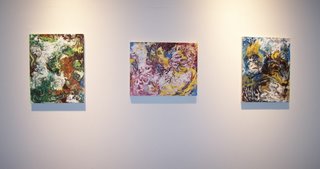
Here too, you'll see directions to William Cordova and Leslie Hewitt's untitled collaborative piece which is on a billboard on the other side the street from Eyedrum Gallery.
(below, Cordova and Hewitt; photo audiologo)


